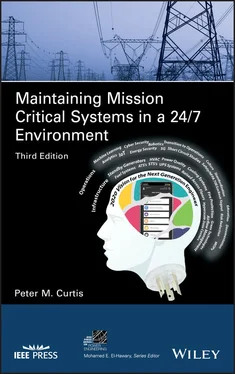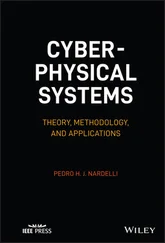Names: Curtis, Peter M., author. | John Wiley & Sons, Inc., publisher.
Title: Maintaining mission critical systems in a 24/7 environment / Peter M. Curtis.
Other titles: IEEE Press series on power engineering.
Description: Third edition. | Hoboken, New Jersey : Wiley‐IEEE Press, [2021] | Series: IEEE Press series on power engineering | Includes bibliographical references and index.
Identifiers: LCCN 2020038739 (print) | LCCN 2020038740 (ebook) | ISBN 9781119506119 (cloth) | ISBN 9781119506126 (adobe pdf) | ISBN 9781119506140 (epub)
Subjects: LCSH: Reliability (Engineering).
Classification: LCC TA169 .C87 2021 (print) | LCC TA169 (ebook) | DDC 620/.00452–dc23
LC record available at https://lccn.loc.gov/2020038739LC ebook record available at https://lccn.loc.gov/2020038740
Cover Design: Wiley
Cover Images: © Sam Robinson/Getty Images, courtesy of Peter M. Curtis
Our lives, livelihoods, and way of life are increasingly dependent on computers and data communication, and this dependence increasingly relies on data centers, where servers, mainframes, storage devices, and communication gear are brought together. In short, we are becoming a datacentric or data center society.
We are all witnessing the extraordinary expansion of the Internet, from social media to search engines, games, content distribution, and e‐commerce. The advent of cloud computing, artificial intelligence and machine learning, virtual and augmented reality, blockchain and Internet of Things will further amplify the importance of the data center as a hub for the new wired world. As we enter the Fourth Industrial Revolution, every aspect of civilization, every region of the globe, will see an acceleration of our society’s Digital Transformation. The COVID‐19 pandemic of 2020 has further reinforced the extent our world is relying on technology. Consequently, there is an ever‐increasing demand on our information infrastructure, especially our data centers, changing the way we design, build, use, and maintain these facilities. However, the industry experts have been slow to document and communicate the vital processes, tools, and techniques needed to do this.
Not only is ours a dynamic environment, but it also is complex and requires an understanding of electrical, mechanical, fire protection, and security systems, reliability concepts, operating processes, and much more. I realized the great benefit Peter Curtis' book will bring to our mission critical community soon after I started reviewing the manuscript. I believe this is the first attempt to provide a comprehensive overview of all the interrelated systems, components, and processes that define the data center space, and the results are remarkable.
Data center facilities are shaped by a paradox: critical infrastructure support systems and the facilities housing them are designed to last 15 years or more, whereas the IT equipment typically has a life of about three years. Thus, every few years, we are faced with major IT changes that dramatically alter the computer technology and invariably impact the demand for power, heat dissipation, and the physical characteristics of the facility design and operation. In addition, the last few years have seen a growing focus on energy efficiency and sustainability, reflecting society's effort to reduce its carbon footprint and reverse global warming. Data centers are particularly targeted by these efforts because they are such huge users of power and because they are scrutinized by the public more than most other sectors.
It is no secret that one of the most difficult challenges facing our industry is our ability to objectively assess risk and critical facility robustness. In general, we lack the metrics needed to quantify reliability and availability, the ability to identify and align the function or business mission of each building with its performance expectation.
Other industries, particularly aircraft maintenance and nuclear power plants, have spent years developing analytical tools to assess systems resiliency, and the work has yielded substantial performance improvements. In addition, the concept of reliability is sometimes misunderstood by professionals serving the data center industry. Curtis' efforts to define and explain reliability concepts will help improve performance in the mission critical space.
Further, the process of integrating all of the interrelated components‐programming space allocation, design, redundancy level planning, engineered systems quality, construction, commissioning, operation, documentation, contingency planning, personnel training, and so on‐to achieve reliability objectives is clear and well‐reasoned. The book plainly demonstrates how and why each element must be addressed to achieve reliability goals. Although this concept appears obvious, it often is not fully understood or accepted, especially in our changing IT world, where we are facing the challenge of finding the right balance between complexity, automation, and human intervention.
The comprehensive review of essential electrical and mechanical systems populating these facilities, from uninterruptible power supplies to cooling systems, from generators, transfer switches to fire protection systems, yields great benefits, not only from a functional standpoint, but also because it provides the necessary maintenance and testing data needed for effective system operation. And, maybe most importantly, Curtis recognizes and deals with the vital human factor, “… perhaps the most poorly understood aspect of process safety and reliability management.”
This third edition is covering some very important new developments in the Data Center design and operation including but not limited to modern cooling solutions, advanced UPS technologies, additional considerations on reliability, resiliency, cyber and physical security, green power, electrical systems maintenance and safety.
As the present generation of professionals that have dedicated their career to designing, operating, and maintaining critical facilities are starting to retire, the next group replacing them needs training, mentoring, and, more importantly, education. This volume will go a long way towards this goal.
I am confident that time will validate the approach and ideas covered here. Meanwhile, we will all profit from this admirable effort to bring a better understanding to this complex and fast‐changing environment.
August, 2020
PETER GROSS
The evolution of our digital society has sped up our lives significantly that a critical event unfolds with extreme rapidness with the exponential growth in technology and constant societal transformation our critical infrastructure is more susceptible and vulnerable to catastrophic and escalating failures. Consequently, we now need to incorporate a new mindset and intelligent decision‐making structures, processes, and tools to manage from a normal day to unpredictable events such as power outages, natural disasters, virus outbreaks, such as COVID‐19, or manmade incidences. This book facilitates bridging the gap between a critical event, a mission critical engineer, and the critical infrastructure that needs to be in place while working to manage throughout the incident with safety, confidence, and situational awareness.
This text intends to provide the foundations of mission critical infrastructure from an engineering and operations perspective. It should be noted that this book is a work in progress and does not include every detail. It does, however, provide foundational topics as well as more advanced subjects of critical infrastructure that are relevant to society today. Topics such as Reliability, Resiliency, Energy Security, UPS Systems, Standby Generators, Automatic and Static Transfer Switches, Power Quality, Data Center Cooling, Efficiency, Air Flow Management, Fire Systems, Raised Floors, Mission Critical Engineering, Safety, Cyber Security, Electromagnetic Pulse, IoT, Machine Learning, Analytics, and Green Practices are discussed in layman’s terms.
Читать дальше












